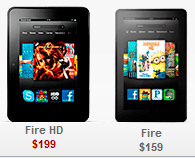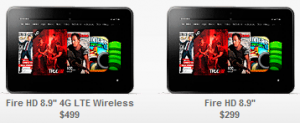
The 7″ Kindle Fire comes in two variants, both WiFi which offer a huge upgrade over last years version
Last week, Amazon wowed the crowds at their recent event with some amazing products. They released a new “Paperwhite” Kindle e-reader, with an updated display for better reading and interaction. They released an updated Kindle Fire, with an updated operating system. This operating system will be available on 4 different devices, two 7″ tablets, and two 8.9″ tablets. Early reports say the devices might be a bit laggy in comparison to their most apt rival (the Google Nexus 7) but those were display devices at a show, not the retail offerings.
The HD devices feature increased screen resolution, a speedy TI OMAP dual-core processor, and increased data transmission speeds. Jeff Bezos has been sure to state that these devices are services, not standalone products. It is likely they will be selling all but the 4G LTE Kindle at a loss. But this is intentional, they want to get users to latch into the Amazon ecosystem, anyway they can.
Amazon is different than Apple or Google, or other manufacturers because their focus is on selling follow on services, not devices. While Apple focuses on both huge margins at the device level as well sales from the iTunes store, they need users to continuously purchase new devices. But Amazon is all but giving away their hardware for minimal costs, and counting on users to load them up with Amazon content.
Amazon’s excellent tablet offerings have provide added value to their ecosystem. Amazon’s story is one of continuous growth and adapting to emerging markets. For now, Amazon offers one of the most compelling tablet ecosystems. In a few weeks, we should hear from Apple their iPad Mini, at which point we will have 3 top-tier 7″ tablet options.
At the end of the day, this year’s Kindle Fires are a huge upgrade over last years. The Amazon Prime offering keeps growing in value, and the recent e-book price-fixing case have opened up the ability of Amazon to provide quality content for low low prices. While the Kindle Fire does not have the Google Play Store, the Amazon Appstore is a suitable replacement. Further, it will most likely be a huge developer favorite (as inexpensive as it is).
The jump from Android 2.3 to 4.0 is big, but is it enough? With Android 4.1 available (Jelly Bean) and on the Nexus 7, is there room for another tablet in the market? I think so, but consumer response will be the real measure. Will you be buying a new Kindle? Please chime in.

This post by RyanKamauff was first published at CTOvision.com.


Leave a Reply
You must be logged in to post a comment.